 |
|
|
| (Information by Peter Kessler, with additional information from The Russian Primary Chronicle (Laurentian Text), Samuel Hazzard Cross & Olgerd P Sherbowitz-Wetzor (Eds and translators, Mediaeval Academy of America), from The Formation of Muscovy 1304-1613, Robert O Crummey, from An Introduction to the History of the Turkic Peoples, Peter B Golden (1992), from the Encyclopaedia Britannica: Or, A Dictionary of Arts, Sciences, and Miscellaneous Literature, Enlarged and Improved, Volume 3, and from External Links: Worldstatesman, and Rurik of Novgorod and the Varangian DNA, and The Fragmentation & Decline of Kievan Rus, and Encyclopaedia.com, and The Map Archive, and The Moscow Times.) |
|
|
| 1547 - 1584 |
Ivan IV Grozny 'the Terrible' |
Grand duke of Moscow. First czar of all the Russias. |
| 1547 - 1558 |
Ivan 'the Terrible' involves the bishop of Dorpat inLivonia in a dispute which becomes the main pretext for the Livonian Wars. Ivan demands that the bishopric pay a huge tribute of 40,000 talers, insisting that city of Dorpat is the ancient Russian fortress of Yuryev, referring to the short term [ Ruthenian](EasternLithuania.htm#Grand Duchy of Lithuania) rule of the area after its conquest by Prince Yaroslav I the Wise of Kyiv between about 1030-1061. Bishop Hermann tries to negotiate a smaller tribute in the interests of extending the truce, but Ivan dismisses the diplomats and assembles his army. 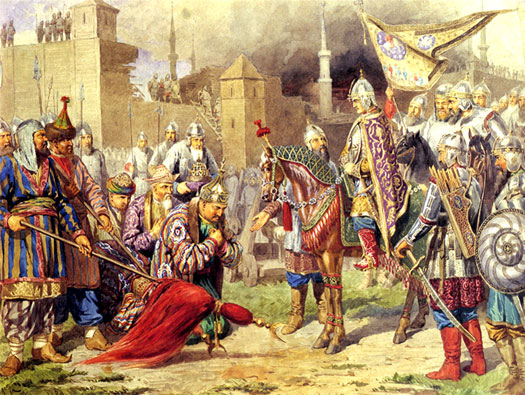 The short-lived Kazan khanate was conquered in 1552 by the resurgent Rus under the leadership of Ivan IV just over a century after Ulugh Muhammad had founded it The short-lived Kazan khanate was conquered in 1552 by the resurgent Rus under the leadership of Ivan IV just over a century after Ulugh Muhammad had founded it |
|
| 1552 |
Ivan conquers the khanate of Kazan. He lays siege to their main fortress for two months before the walls are destroyed. Most of the surviving defenders are slaughtered. Yadigar Muhammad, the ruling khan, is imprisoned but the slaughter spreads to the civilian populace, with a reported 110,000 or so being killed. Neighbouring territories such as Udmurtia surrender without a fight, and many Tartars are forcibly relocated so that Russian nobles can take over their lands. |
|
| 1554 - 1555 |
Astrakhan is attacked in 1554. The khanate's ruler, Yaghmurchi, is defeated at the Battle of Xacitarxan (Astrakhan) and is forced to flee across the River Terek to the south, in Dagestan, close to the Caucus Mountains. In 1555 he is killed, either by the Russians, or by the Nogais, or by his own successor (sources conflict). The Russians and Nogais have already ensured that their own candidate to rule Astrakhan, Darwish Ali, is able to seize control (the khanate is extinguished in 1557). |
|
| 1558 - 1560 |
In the very first stage of the Livonian Wars in 1558, the city of Dorpat is conquered by Russian troops and the bishopric ceases to exist. The Russians also claim a success when they completely destroy the army of the Livonian Knights at the Battle of Ergeme in 1560, forcing the Order to dissolve itself the following year and submit to [ Lithuania](EasternLithuania.htm#Grand Duchy of Lithuania). |
|
| 1570s |
The fight for the Baltic states is not yet over. In this decade, the Russian army launches a new offensive, and reaches [Riga](EasternLatvia.htm#Polish Governors) and Tallinn under the command of Ivan 'the Terrible'. He does not manage to capture either town. During the same period, there are further raids by the Crimean Tartars. The most serious of them, in 1571, sees Moscow in flames, but the Russians gain their revenge in the following year, at the Battle of Molodi. 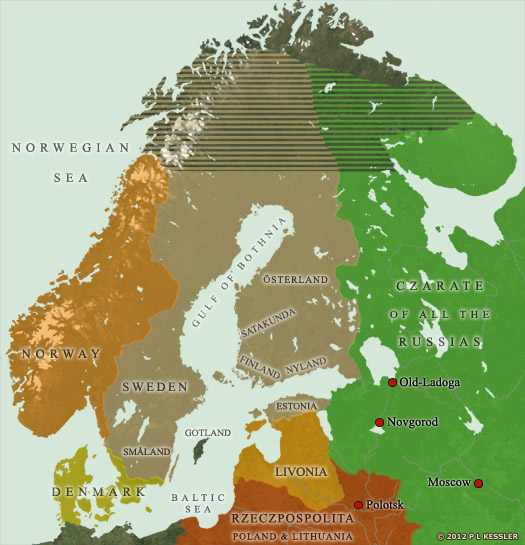 This map of the Nordic countries and the western czarate after AD 1581 reveal the massive advance of Moscow's controlled territories since the ending of Mongol overlordship (click or tap on map to view full sized) This map of the Nordic countries and the western czarate after AD 1581 reveal the massive advance of Moscow's controlled territories since the ending of Mongol overlordship (click or tap on map to view full sized) |
|
| 1581 |
The reign of John III of Sweden sees [Finland](ScandinaviaFinland.htm#Grand Duchy) raised to a grand duchy, with the king himself holding the title and governors being appointed to handle the day-to-day running of the country. This is part of the king's policy of opposing the various grand duchies claimed by Ivan IV. Ingria, Karelia, and [Livonia](EasternLatvia.htm#Polish Governors) are similarly raised, creating a line of grand duchies along the border with Russia. In the same year, 1581, the Estonian county of Läänemaa is conquered by Sweden, removing it from the control of Ösel and giving Sweden control of all of North Estonia. |
|
| 1582 |
The khanate of Siberia is conquered after an initial Russian attack is unsuccessful. Khan Kuchum is forced to flee under cover of darkness, leaving his capital in Russian hands. Kuchum's claim to rule the khanate lingers on until 1598 but with decreasingly few followers. |
|
| 1582 - 1583 |
An armistice agreement is concluded between Ivan and the Polish-Lithuanian kingdom, proclaiming [Livonia](EasternLatvia.htm#Polish Governors) a possession of the latter. In 1583, Russia concludes a similar agreement with Sweden, acknowledging its supreme power in North Estonia, ending the Livonian Wars. |
|
| 1584 - 1598 |
Fedör / Theodore I 'the Bellringer' |
Second son. Last direct line Rus Rurikid. Died childless. |
| 1595 |
The Teusina Treaty agrees peaceful terms between Sweden and Russia. Kvenland ('Kaianske landet') is mentioned for the first time in an official government document as a territory which is governed by Sweden, although in reality this claim is not entirely merited. 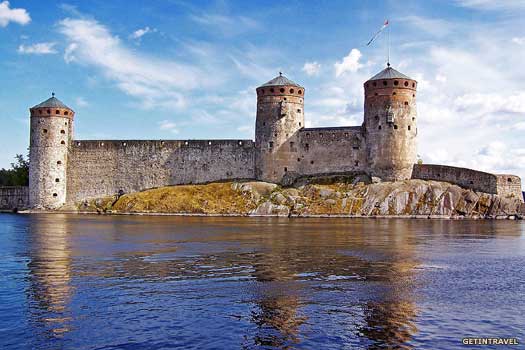 The late fifteenth century Olavinlinna Castle was constructed in Savonlinna by Erik Axelsson in an attempt to lay claim to the recently acquired Russian side of the Finnish border The late fifteenth century Olavinlinna Castle was constructed in Savonlinna by Erik Axelsson in an attempt to lay claim to the recently acquired Russian side of the Finnish border |
|
| 1598 - 1605 |
Boris Godunov |
Relation by the marriage of Ivan IV. Governed under Feodor. |
| 1605 |
The death of Boris Godunov and the accession of his capable sixteen year-old son as Feodor II prompts enemies of the Godunovs to protest. Envoys of an opposition leader by the name of Dimitri ('False Dimitry I', having claimed to be a son of Ivan 'the Terrible') enter Moscow to demand that Feodor is removed. They read out sensitive letters in Red Square which turns some of the boyars against Feodor. These boyars seize the young czar and arrest him. Both he and his mother are soon murdered. The 'Time of Troubles' has begun. |
|
| 1605 |
Fedör / Feodor / Theodore II |
Son. Murdered by Godunov rivals. |
| 1605 - 1606 |
Dimitri I 'the Imposter' / 'False Dimitry I' |
Pretender. Murdered for welcoming [Catholics](ItalyPopes.htm#Early Modern) into Russia. |
| 1605 - 1618 |
The Polish-Muscovite War is triggered (also known as the Polish-Russian War or, in Poland-Lithuania, the Dimitriads). It forms an eastwards extension of the ongoing struggle of wills with Sweden, as both sides make the most of the dynastic problems of the Russian czarate which are known internally as 'The Times of Troubles'. The fighting is not continuous, and the sides switch constantly as objectives and opportunities evolve. The Russians themselves spend a good deal of the conflict fighting one another, both with and without Swedish or Polish allies, and the aristocracy of the Polish commonwealth also lead their own private or mercenary armies against targets of their choosing as they attempt to expand into czarate territory. The war is not formally declared by Poland until 1609, with Sweden's formal involvement taking place as part of the Ingrian War (1610-1617). 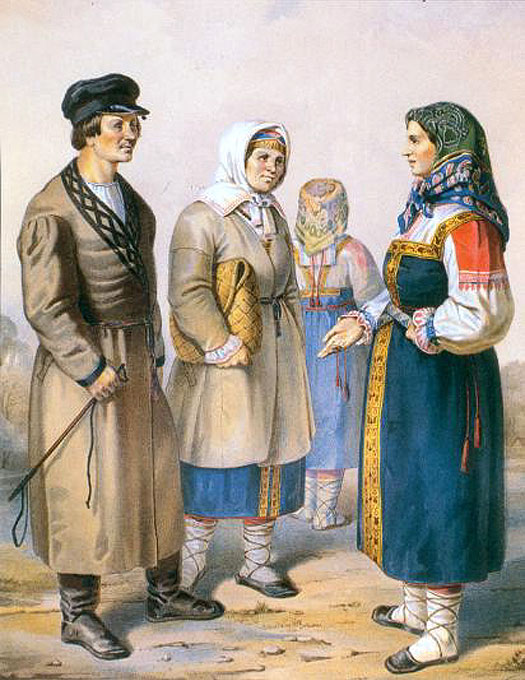 Ingrians were the Finno-Ugric cousins of the Estonians, Finns, Livs, Karelians, Wots, and Weps, many of whom were forcibly integrated into the Russian czarate and later empire Ingrians were the Finno-Ugric cousins of the Estonians, Finns, Livs, Karelians, Wots, and Weps, many of whom were forcibly integrated into the Russian czarate and later empire |
|
| 1606 - 1610 |
Basil Shuisky / Vasili IV |
The last (distant) Rurikid. Deposed by the 'Seven Boyars'. |
| 1607 - 1610 |
Pseudo-Demetrius / 'False Dimitry II' |
Pretender. Never ruled in Moscow. Killed by Tartars. |
| 1610 - 1612 |
Wladyislaw / Ladislaus |
Future king of Poland (1632-1648). Elected czar - never ruled. |
| 1611 |
Pseudo-Demetrius / 'False Dimitry III' |
Pretender. Swiftly captured and executed. |
| 1610 - 1613 |
With Sweden seemingly allied more closely to Russia, Sigismund III of Poland-Lithuania is invited to 'capture' Moscow and Smolensk in 1610 by the 'Seven Boyars' (seven influential nobles who had only just deposed Vasili IV). His son, Wladyislaw, is elected czar of the Russias by the Seven Boyars but he does not take up his position due to opposition by Sigismund. The rule of the Rurikids has already been brought to an end, although Sigismund himself is soon forced out by popular resistance in Moscow. There follows an interregnum in the Russian czarate and a period of renewed civil war whilst the wider conflict rumbles on until 1618, when an armistice is agreed in the village of Deulino, heralding the start of the Romanov dynasty of rulers. |
|
|
|
|
| Romanov Czars of the Russias (Russian Empire) AD 1613 - 1917 Descendants of Rurik of Novgorod had ruled Kievan Rus since the late ninth century (albeit arguably, since some of the early leaders may not have been related to Rurik). The 'Russias' were the lands of the Rus, which gradually broke up into semi-independent principalities in the eleventh and twelfth centuries before one of them sacked Kyiv to claim Rus supremacy for Vladimir-Suzdal. This principality became a major centre of Rus power and settlement immediately before the arrival of the Mongols and the eventual ending of Old Rus independence at the hands of the Golden Horde. Out of the loss of the Old Russian state, a new one emerged during Mongol hegemony, in the form of Moscow. This quickly became a leading power in Rus lands before becoming the only power after it absorbed the last of its opposition. Moscow's regional dominance expanded outwards gradually, but the early seventeenth century interregnum and civil war known as 'The Time of Troubles' following the murder of Czar Dimitri I set the city back somewhat. The same nobles who ignominiously deposed one of Dimitri's many successors invited Sigismund III of Poland-Lithuania into Moscow in 1610 and subsequently elected his son, Wladyislaw, as czar. Wladyislaw was unable to take up the position due to his father's opposition, and the czarate continued to fight itself for three years without any czar at all. Russia also remained at war with Poland until 1618. The Romanovs formed Russia's second dynasty. Michael Romanov was descended from the largely mysterious Boyar Andrei Ivanovich Kobyla who received his only mention in history in theMoscow State of 1347. During the reign of Ivan IV 'the Terrible' (1547-1584), Koblya's descendants via his son, Feodor, became known as the Yakovlev family. However, the grandchildren of one of them, Roman Yurievich Zakharyin-Yuriev, assumed a form of clan name by adopting Roman Yurievich's first name as the 'Romanovs' (essentially meaning the clan or descendants of Roman). His daughter had been the wife of Ivan IV, bringing the family great wealth and power despite later problems during the short reign of Boris Godunov (1598-1605). Following the expulsion of the Poles in 1612, the crown was offered to several Rurik and Gedimin princes whilst a number of pretenders also sought to claim the throne. In the end the son of the highly respected Filaret Romanov was asked - the sixteen year-old Mikhail Romanov (nephew of Czar Fedör I). Once he had been persuaded to accept by his mother, Kseniya Ivanovna Shestova, he pursued a policy of emphasising family ties with the Ruriks through marriage to Ivan IV. He also made sure that he asked the advice of the 'Assembly of the Land' on important issues, thereby ensuring that the populace loved him and the nobility respected him. |
|
|
 |
|
|
| (Information by Peter Kessler, with additional information from Indian Frontier Policy, John Ayde (2010), from the Encyclopaedia Britannica, from the Brockhaus and Efron Encyclopaedic Dictionary (1906), from the Almanach de Gotha (2012), from The Formation of Muscovy 1304-1613, Robert O Crummey, from History of the World: Volume 7, Arthur Mee, J A Hammerton, & Arthur D Innes (1907), from The First World War, John Keegan (Vintage Books, 2000), and from External Links: Imperial House (used with care, now a dead link), and The Napoleon Series, and Jewish Encyclopaedia.) |
|
|
| 1613 - 1645 |
Mikhail / Michael I Romanov |
Son of Filaret Romanov. Aged 16 at accession. |
| 1617 - 1618 |
The wars against Sweden and Poland-Lithuania are quickly ended by Michael I with the signing of the Peace of Stolbovo (17 February 1617) and the Truce of Deulino (1 December 1618) respectively. The latter achievement allows the return of Michael's father from exile. Filaret Romanov largely assumes the duties of the czar's office without taking on the trappings of power. Michael's position is largely ceremonial until his father's death in 1633. 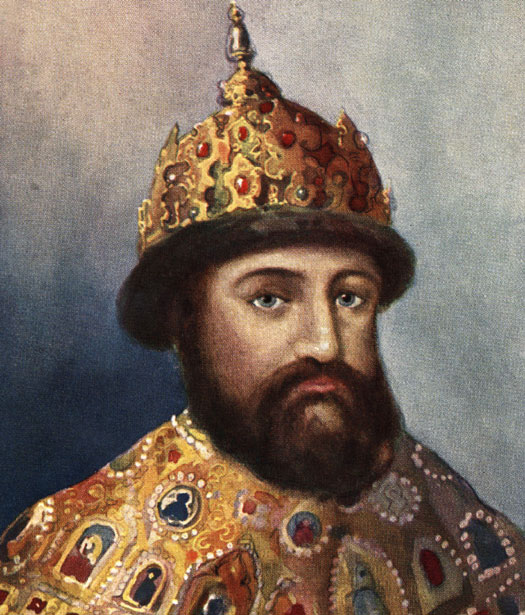 Michael Romanov was the first Russian czar of the House of Romanov, but it would be his successors who turned the czarate of the Russias into an empire Michael Romanov was the first Russian czar of the House of Romanov, but it would be his successors who turned the czarate of the Russias into an empire |
|
| 1618 - 1633 |
Filaret Romanov |
Father and de facto ruler during his remaining lifetime. |
| 1645 - 1676 |
Aleksei / Alexis |
Son of Michael. A competent ruler in troubled times. |
| 1651 - 1653 |
The Russo-Persian War sees Safavid troops and their allies in Dagestan attacking Russian fortifications along the Sunzha. The Dagestani units are led by Khan of Derbent, the governor of the region, who is possibly also the instigator of the violence. The intention is to strengthen the Persian position in the North Caucasus. Alexis sends an embassy to Iran to conclude a peaceful settlement of the conflict, which succeeds in August 1653. |
|
| 1652 |
 The reforms of Aleksei and Patriarch Nikon to Russian Orthodox ritual and worship causes a section of the Church's congregation to secede during the Great Schism. Many 'Old Believers' who refuse to follow the new practises migrate westwards, to the shores of Lake Peipsi in Estonia to form small fishing communities which continue to trade at St Petersburg (see feature link). Others are killed in their thousands, or commit suicide by setting themselves alight rather than obey the czar's reforms. The reforms of Aleksei and Patriarch Nikon to Russian Orthodox ritual and worship causes a section of the Church's congregation to secede during the Great Schism. Many 'Old Believers' who refuse to follow the new practises migrate westwards, to the shores of Lake Peipsi in Estonia to form small fishing communities which continue to trade at St Petersburg (see feature link). Others are killed in their thousands, or commit suicide by setting themselves alight rather than obey the czar's reforms. |
|
| 1654 - 1655 |
Poland-Lithuania is dragged into the Russo-Polish War over control of Kyiv, the south-easternmost of the Polish Commonwealth's territories. Russian troops seize the most important centres of the [ Lithuanian](EasternLithuania.htm#Grand Duchy of Lithuania) grand duchy - Smolensk, Vitebsk, Mogilev, and Minsk - and for the first time in Lithuanian history Vilnius is occupied, followed shortly afterwards by Kaunas and Grodno. The commonwealth's king is exiled between September and November in 1655 while the Dnieper Cossacks now ally themselves with Russia, providing an additional threat to the Crimean khanate. 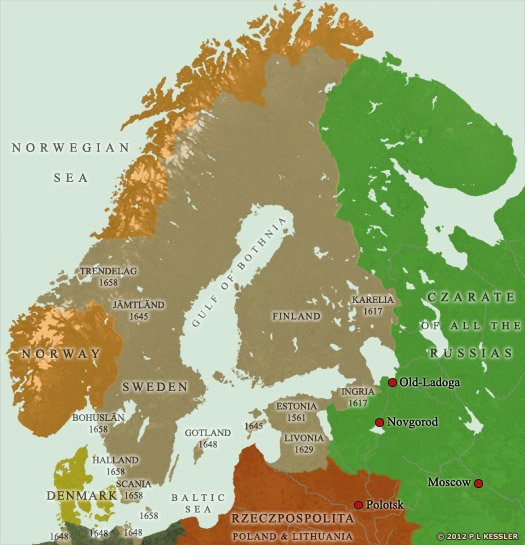 The Swedes had removed themselves from the Union of Kalmar with Denmark and Norway in 1523, and since that time had built up a Nordic empire of their own which now dominated the eastern lands and Baltic territories - prime targets for Russian expansion (click or tap on map to view full sized) The Swedes had removed themselves from the Union of Kalmar with Denmark and Norway in 1523, and since that time had built up a Nordic empire of their own which now dominated the eastern lands and Baltic territories - prime targets for Russian expansion (click or tap on map to view full sized) |
|
| 1654 - 1658 |
A Russian expeditionary force which enters the [ Qin](../KingListsFarEast/ChinaDynastiesOld.htm#Manchu Dynasty) lands is defeated by a combined Qin and Joseon army at the Battle of Hutong (today's Yilan in far north-western China). A second Russian expedition into Qin lands in 1658 is similarly ejected by combined Qin and Joseon forces. |
|
| 1669 - 1671 |
Under pressure for years by heavy taxes and unsettled political conditions, the Don Cossacks in southern Russia now rebel. Led by Stenka Razin, a disaffected Don Cossack, they capture the Russian city of Astrakhan on the northern shore of the Caspian sea. Then they expand their operations to seize several towns along the River Volga. Stenka Razin becomes involved in the siege of Simbirsk in October 1670. This fails, and Razin is eventually captured on the Don in April 1671. His punishment is to be drawn and quartered in Moscow. |
|
| 1676 - 1682 |
Fedör / Feodor / Theodore III |
Son. Acceded aged 15. Died without any surviving offspring. |
| 1678 |
The rapid growth of Russian territory finally prompts a serious Ottoman campaign to expel the Russians from the Ukraine 'border' region to the east of Kyiv. A large Ottoman army is sent against them, supported by Tartar cavalry. The offensive culminates in the siege of the strategic city of Cihrin. Russian attempts to relieve the city fail, and the Ottomans are able to secure a favourable treaty. However, although the Russians are temporarily pushed back, continued warfare along the Polish frontier forces the Ottomans to discontinue their Ukrainian campaign. |
|
| 1682 - 1689 |
The death of Fedör sparks the Streltsy Uprising or Moscow Uprising of 1682. Behind it are the two wives of the late Czar Aleksei, who are striving for domination. The uprising of the Moscow Streltsy regiments provides Sofia Alexeyevna, daughter of Maria Miloslavskaya, with supreme power as regent of Russia. Ivan and Peter, both still minors, accede to the throne (with a two-seater throne made especially for them), but Sofia is in charge. She rules with an iron fist and a heavy hand. 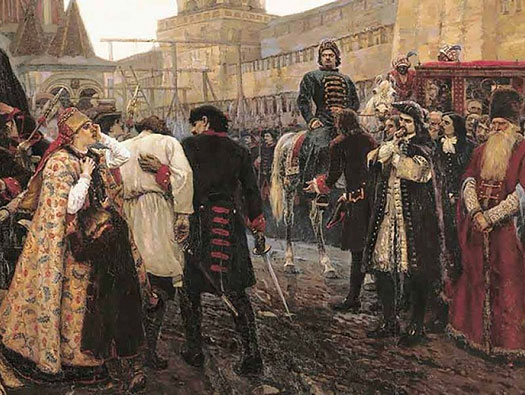 The Streltsy Uprising resulted in executions, as depicted in this fragment of the 'Morning of the Streltsy execution' The Streltsy Uprising resulted in executions, as depicted in this fragment of the 'Morning of the Streltsy execution' |
|
| 1682 - 1696 |
Ivan V |
Brother. Czar in name only due to severe disabilities. |
| 1682 - 1725 |
Peter I the Great |
Half-brother and co-czar during Ivan's lifetime. |
| 1682 - 1689 |
Sofia Alexeyevna |
Sister of Ivan V and regent. Deposed. |
| 1688 - 1689 |
Peter reaches the age of sixteen in 1688, and begins to impose his will on events. Power in the royal court gradually shifts from Sofia to him as he makes his own appointments. In 1689 Sofia considers pronouncing herself czarina but her broad support has already waned. Then she offers a joint throne to Peter, who refuses. Instead she is arrested and sent in virtual exile to Novodevichy Convent (Ivan V survives as the now-junior co-czar until his death in 1696, after which Peter is sole czar). In the same year, 1689, the Treaty of Nerchinsk is signed, the first treaty between Russia and [ Qin](../KingListsFarEast/ChinaDynastiesOld.htm#Manchu Dynasty) China. It delineates the border between their respective empires, largely placing the hunter-gatherer Tungusic peoples on the Russian side while China dominates their sedentary groups around the River Amur. |
|
| 1696 |
While the Ottomans are preoccupied in the Balkans against [Austria](GermanyAustria.htm#Habsburg Archdukes), Poland-Lithuania, and Venice, Peter the Great leads an attack against the Ottoman fortress of Azov in the heart of the Crimean khanate. He finally captures it in this year, although the Tartars manage to evade two other Russian invasions during the war. This series of campaigns signal the beginning of an ominous new era in the khanate's relationship with Russia, as its neighbour is able to steadily penetrate its frontier as never before. 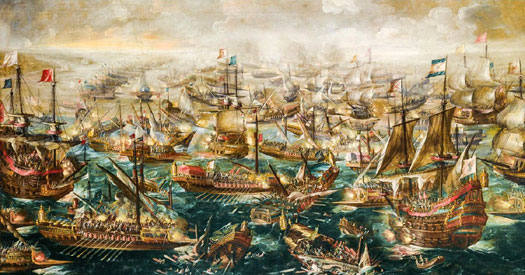 European victory at the Battle of Lepanto (in which Venice's navy was heavily involved) was considered the saviour of Europe itself from the advancing Ottoman threat, shown in this 1640 oil by Andries van Eertvelt (1590-1652) European victory at the Battle of Lepanto (in which Venice's navy was heavily involved) was considered the saviour of Europe itself from the advancing Ottoman threat, shown in this 1640 oil by Andries van Eertvelt (1590-1652) |
|
| 1700 |
Russia adopts the already-outdated Julian calender on the orders of the czar while Western Europe is in the process of switching to the Gregorian calender. The Russian year of 7207 - as calculated from the purported beginning of the world ('Anno Mundi', meaning 'from the world's creation') - is replaced by the year 1700 and the date upon which the new year is celebrated is switched from 1 September to 1 January. In the same year Sweden finds itself attacked by Russia, Poland, and Denmark in the Great Northern War (alternatively entitled the Second Northern War) which lasts until 1721. Sweden's expansion at the end of the Livonian Wars had antagonised several states, notably those on the receiving end of defeats such as Russia and Denmark. The latter state takes the opportunity presented by the death of Charles XI of Sweden to organise an anti-Swedish coalition. 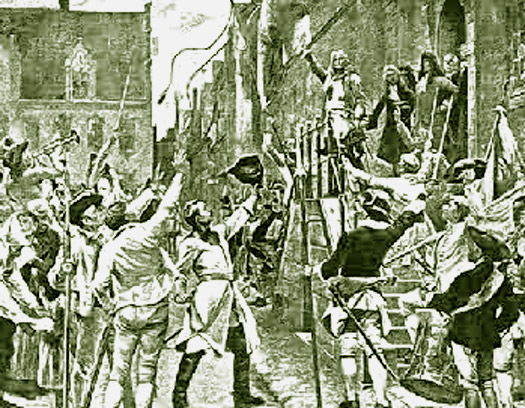 The capture of the town of Malmo in 1709 by Count Magnus Stenbock was probably one of the last Swedish victories as Russia and her allies defeated the Swedes later the same year The capture of the town of Malmo in 1709 by Count Magnus Stenbock was probably one of the last Swedish victories as Russia and her allies defeated the Swedes later the same year |
|
| 1709 - 1710 |
Czar Peter defeats and effectively destroys the Swedish empire at the Battle of Poltava, in Ukraine in 1709, during the Great Northern War. The Swedish army is forced to surrender at Perevolochna. The following year, the growing Russian empire gains control of [Finland](ScandinaviaFinland.htm#Grand Duchy), Estonia, and [Livonia](EasternLatvia.htm#Russian Governors). |
|
| 1717 - 1718 |
The discovery of gold along the banks of the Amu Darya has prompted a good deal of interest in the khanate of Khiva by various great powers. Peter the Great sends a 'trade' expedition under the command of Prince Alexander Bekovich-Cherkassky which comes complete with a considerable number of armed men. It fails to secure Russian ambitions in the region, however, because Shir Ghazi slaughters all but ten of the men. After his Swedish and Ottoman conflicts, Peter is unable to raise any funds to mount a retaliatory strike. 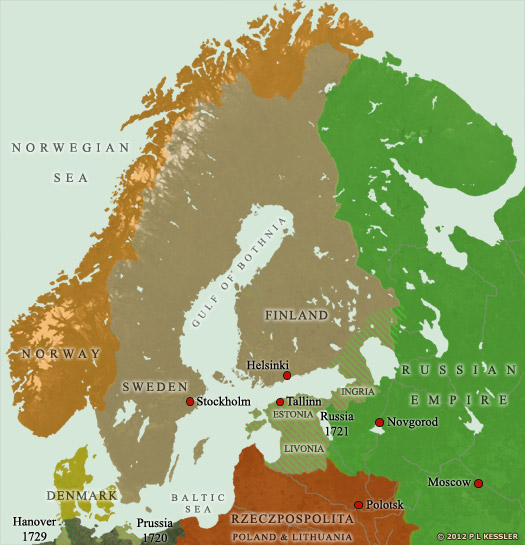 This map displays Nordic borders following the conclusion of the Great Northern War in 1721 (click or tap on map to view full sized) This map displays Nordic borders following the conclusion of the Great Northern War in 1721 (click or tap on map to view full sized) |
|
| 1721 |
The Great Northern War is ended with the Treaty of Nystad by which time Russia has already gained much influence in the duchy of Courland with the marriage of Princess Anna Ivanova (later empress in 1730) to the ruling duke. That duchy, plus Ingria, Estonia, and [Livonia](EasternLatvia.htm#Russian Governors), are confirmed as Russian possessions. Large numbers of Ingrian Finns (not to be confused with Izhorian-speaking Ingrians) migrate back into [Finland](ScandinaviaFinland.htm#Grand Duchy) proper as Russia starts to impose its own rule on the region. Peter is subsequently proclaimed 'Emperor of All Russia', although only Poland-Lithuania, Prussia, and Sweden recognise this claim. |
|
| 1722 - 1723 |
Sensing the weakness of the Safavid empire, Peter launches the Russo-Persian War of 1722-1723. Otherwise known as the 'Persian Expedition of Peter the Great', the war is designed to increase Russian influence in the Caucasus and prevent the Ottoman empire from increasing its own regional authority. Astrabad, Baku, Derbent, Gilan, Mazandaran, and Shirvan are all successfully won (only to be subsequently leased back to Persia between 1732-1735 now that the two states are allies). 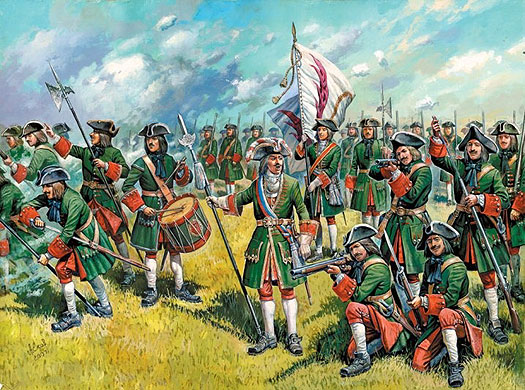 Peter the Great spotted the military weakness of Iran and its provinces and began a long-running Russian push to extend his empire's borders southwards with his modernised army Peter the Great spotted the military weakness of Iran and its provinces and began a long-running Russian push to extend his empire's borders southwards with his modernised army |
|
| 1725 - 1727 |
Catherine I |
Wife of Peter I, and czarina in her own right after his death. |
| 1727 - 1730 |
Peter II |
Son of Tsarevich Alexei Petrovich (son of Peter I). |
| 1730 - 1740 |
Anna / Anne |
Dau of Ivan V. Former regent of Courland. |
| 1735 - 1739 |
The recent Ottoman-Persian War and the subsequent peace treaty results now in the Austro-Russo-Turkish War (1735-1739). The main excuse for the war is continued raiding for slaves by the Crimean khanate on the Cossack Hetmanate of Ukraine, and a Crimean military excursion into the Caucasus. The Russians plunge deep into poorly-defended Crimean territory, burning as they go. Even the Ottoman fortress at Azov is captured, so that the caliph at Constantinople is forced to remove Crimean khans Qaplan Giray I (in 1736) and Fetih Giray II (in 1737) from their positions for their failures. Plague also sweeps through the combatants, sometimes reducing the fighting to little more than minor border skirmishes. [Austria](GermanyAustria.htm#Habsburg Archdukes)'s own participation in the war against the Ottomans in 1737 ends in several Austrian defeats. |
|
| 1737 |
Anna Ivanova, following her accession to the imperial throne, places her own candidate in charge of the duchy of Courland. He is Ernst Biron, but he is soon exiled by the new regime in St Petersburg following Anna's death. Despite this he continues to claim to rule there. |
|
| 1740 - 1741 |
Ivan VI |
Grand-nephew. Infant at accession. Usurped and imprisoned. |
| 1740 - 1741 |
Anna Leopoldovna / Carlovna |
Mother and regent. Niece of Anna. Exiled. |
| 1741 - 1762 |
Elizaveta / Elizabeth Petrovna |
Dau of Peter I. Usurper. Last direct Romanov descendant. |
| 1741 - 1743 |
A Swedish attempt to regain territory lost to Russia backfires in the Russo-Swedish War, which is part of the greater [**Austrian**](GermanyAustria.htm#Habsburg Archdukes) War of Succession. Also known as the Hats' Russian War, the Russian forces sweep the Swedes back to Helsinki where they surrender, and [Finland](ScandinaviaFinland.htm#Grand Duchy) is again occupied while peace negotiations rumble on. The Lesser Wrath, as this event is known, sees Sweden further diminished as a great power when it is forced to hand over the Finnish towns of Hamina and Lappeenranta, along with a strip of territory lying to the north-west of St Petersburg. The River Kymi is set as the new border. 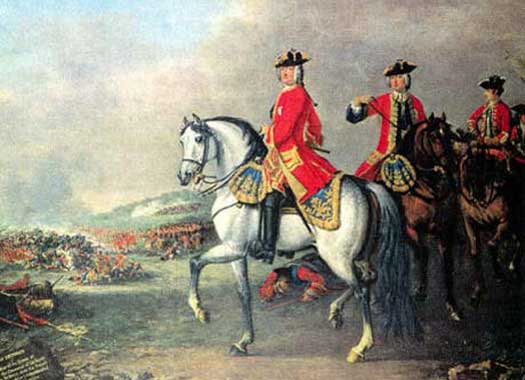 The War of the Austrian Succession saw Europe go to war to decide whether Maria Theresa would secure the throne left to her by her father, but several other issues were also decided as a wide range of wars were involved in the overall conflict The War of the Austrian Succession saw Europe go to war to decide whether Maria Theresa would secure the throne left to her by her father, but several other issues were also decided as a wide range of wars were involved in the overall conflict |
|
| 1762 |
The direct line of Romanov rulers dies out with Elizabeth Petrovna (although the direct male line had already ended with the death of Peter II). A period of crisis follows the death as a suitable candidate is sought amongst various more distant relatives. In the end, a grandson of Peter I is found in the House of Holstein-Gottorp, a junior (cadet) branch of the House of Oldenburg. Peter III (born Karl Peter Ulrich) is the product of a marriage between Grand Duchess Anne, daughter of Peter I, and Duke Charles-Frederick of Holstein-Gottorp. Although generally acclaimed as a Romanov, in fact he begins the line of Holstein-Gottorp-Romanov which rules Russia until 1917. |
|
| 1762 |
Peter III |
First Holstein-Gottorp-Romanov czar. Assassinated. |
| 1762 |
Peter III is assassinated after only six months on the throne, although the circumstances of his death seem uncertain. As the duke of Holstein-Gottorp he has an extra degree of interest in affairs in Germany, perhaps too much for some elements of the Russian nobility. He plans an attack on Denmark in order to restore areas of Schleswig to his duchy, and withdraws Russian troops from the Seven Years' War. In the end, the plot to depose him is led by his own wife. He is transported to captivity at Ropsha, where he dies in mysterious circumstances. Catherine takes over, but is beset by various claimants to be Peter, not dead after all. One of them also claims to be Jesus. |
|
| 1762 - 1796 |
Yekaterina / Catherine II the Great |
Wife, and czarina in her own right after Peter's death. |
| 1762 |
With an increase of direct Russian control of the Baltic states in mind, Catherine orders [ Livonia](EasternLatvia.htm#Russian Governors) to be administered directly by the governor-general of the Baltic Provinces, Count George Browne. Estonia is forced to follow suit in 1775. |
|
| 1764 |
The imperial province of Novorossiya (New Russia) is formed along the central northern area of the Black Sea coast (now part of Ukraine). The province is a merging of several military districts and the Cossack Hetmanate in order to improve and increase Russian control of the region as part of the ongoing process of impinging upon Ottoman territory to the south. 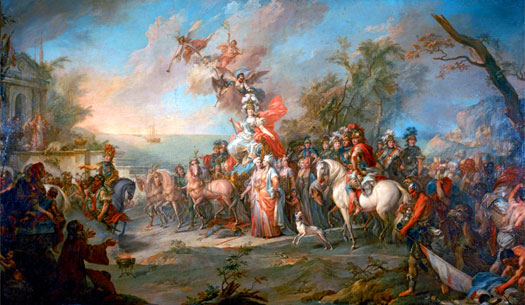 Torelli Stefano's Allegory of Catherine the Great's Victory over the Turks and Tatars was painted in 1772, combining images of concrete historical personages with figures from the artists' free-flying imagination - the painting was commissioned to glorify the victory of the Russian army in the first Russo-Turkish War (1768-1774) and Catherine the Great is portrayed as the goddess Minerva in a triumphal chariot (click or tap on image to view full sized) Torelli Stefano's Allegory of Catherine the Great's Victory over the Turks and Tatars was painted in 1772, combining images of concrete historical personages with figures from the artists' free-flying imagination - the painting was commissioned to glorify the victory of the Russian army in the first Russo-Turkish War (1768-1774) and Catherine the Great is portrayed as the goddess Minerva in a triumphal chariot (click or tap on image to view full sized) |
|
| 1767 |
After this date, all of Alania falls under the rule of the Russian empire as part of Catherine's thrust southwards through the Caucasus to remove these territories from Ottoman influence. The peoples are generally converted to the Russian Orthodox church and in terms of identity they form the Ossetians, based in modern Georgia and the bordering Russian republics. |
|
| 1768 -1774 |
The First Russo-Turkish War is part of Catherine's move to secure the conquest of territory on Russia's southern borders. Following the repression of revolts in Poland-Lithuania, Russia becomes involved in chasing rebels across the southern border into Ottoman territory. The Ottomans imprison captured Russian forces, effectively declaring war. Despite being slow to mobilise, in 1774 Russia wins Kabardia (in the northern Caucasus), part of the Yedisan between the Bug and Dnieper (now covering south-western Ukraine and south-eastern Moldova (southern Transnistria), and the Crimea region. [Georgia](EasternGeorgia.htm#Kingdom of Kartl-Kakheti) also joins the Russian empire as a client kingdom while the khanate of Crimea is granted nominal independence. |
|
| 1772 |
As part of Catherine's successful policy of expanding the Russian empire southwards and westwards during what becomes seen as its golden age, Russia shares the spoils during the First Partition of Poland-Lithuania, gaining Polish Livonia (Latgallia) and [ Lithuania](EasternLithuania.htm#Grand Duchy of Lithuania). 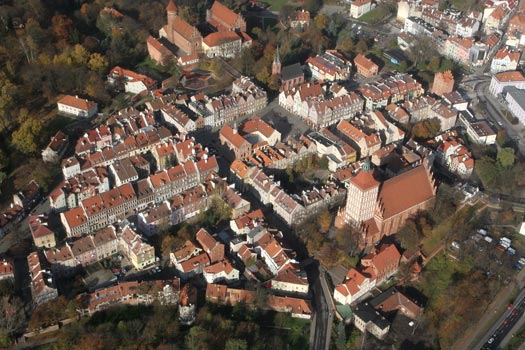 The city of Olsztyn (or Allenstein in German) was seized by Prussia in the 1772 partition of Poland-Lithuania, but Russia and Austria also seized their own prizes The city of Olsztyn (or Allenstein in German) was seized by Prussia in the 1772 partition of Poland-Lithuania, but Russia and Austria also seized their own prizes |
|
| 1773 - 1775 |
Perhaps the most serious revolt which takes place during Catherine's expansionist foreign policy is the Cossack Rebellion, also known as Pugachev's Rebellion. The Ural Cossacks rebel against the high taxes being imposed on their main livelihood, the fishing industry. They are united under the leadership of former Russian army lieutenant, Yemelyan Pugachev, but when he proclaims the formation of an alternative Russian government in the name of Peter III and the end of serfdom, action has to be taken against him. The Battle of Kazan (actually two back-to-back battles) takes place on 12-15 July 1774, and the rebel forces are crushed. The rebellion is finally ended before the year is out. |
|
| 1778 - 1790 |
Having secured the Swedish throne through force, Gustavus conducts two failed military campaigns in 1788-1790, first to capture Norway and then to recapture the Baltic Provinces from Russia. |
|
| 1783 - 1786 |
Despite having guaranteed its independence in 1774, Catherine now formally annexes the khanate of Crimea. This removes any possibility of Ottoman influence or domination. She also agrees with the Treaty of Georgievsk to protect [Georgia](EasternGeorgia.htm#Kingdom of Kartl-Kakheti) from any fresh Persian attacks. In 1786 Catherine takes part in a procession in the Crimea to celebrate the event, which itself sparks the Second Russo-Turkish War. 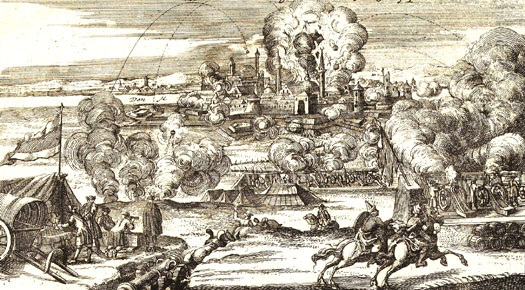 The Siege of Azov in 1736 had been part of the greater Austro-Russo-Turkish War (1735-1739) and had already seen the Russians capture the Ottoman fortress of Azov for a second, and final, time in their ongoing on-off conflict The Siege of Azov in 1736 had been part of the greater Austro-Russo-Turkish War (1735-1739) and had already seen the Russians capture the Ottoman fortress of Azov for a second, and final, time in their ongoing on-off conflict |
|
| In 1784 the newly-formed Shelikhov-Golikov Company (in 1783) gains the charter for the Russian exploitation of Russian America's resources. Founded by Grigory Shelikhov and Ivan Golikov (1729-1805), this is the first attempt to found a permanent settlement in Alaska following around forty years of relatively low key fur trading. |
|
|
| 1787 - 1792 |
The Second Russo-Turkish War is part of the ongoing struggle for hegemony between the Russian and Ottoman empires around the Black Sea coast. Stung by the apparent permanent loss of the Crimea, the Ottoman empire launches a campaign to regain territory which had been lost to Russia in the previous Russo-Turkish War. The Ottomans have to fight on two fronts - the other being the Austro-Turkish War of 1787 - as [ Austria](GermanyAustria.htm#Habsburg Archdukes %28Lorraine%29) and Russia have agreed an alliance. Ottoman troops are hopelessly ill-prepared and badly led, and their defeats results in the sudden death of Sultan Abdul-Hamid I. Russia gains Yedisan (Odessa and Ochakov), while the Dniester becomes the new frontier. From 1791, Russia operates an area known as the '[Pale of Settlement](EasternLithuania.htm#Russian Governors)'. Initially this is small, but it increases greatly from 1793 and the Second Partition of the former Polish-Lithuanian commonwealth. By the mid-nineteenth century it incorporates modern Belarus (eastern Poland at the time), eastern [Latvia](EasternLatvia.htm#Russian Governors),[Lithuania](EasternLithuania.htm#Russian Governors), the province of Bessarabia (modern Moldova), and western Ukraine. Having formerly been citizens of the defunct commonwealth, the Jewish Diaspora population of the 'Pale' (mainly Ashkenazi Jews) is restricted from moving eastwards into Russia proper. 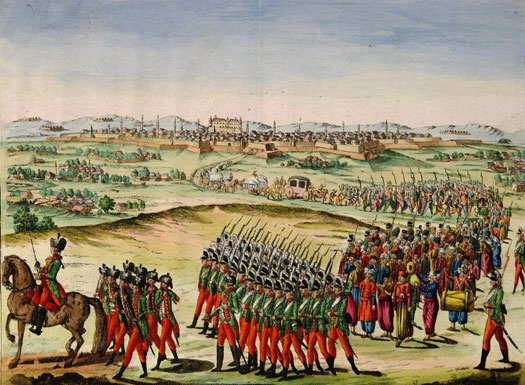 The Second Russo-Persian War in 1787-1792 witnessed a continuation of imperial Russia's push to extend its borders southwards at the expense of the weakening Muslim powers The Second Russo-Persian War in 1787-1792 witnessed a continuation of imperial Russia's push to extend its borders southwards at the expense of the weakening Muslim powers |
|
| 1793 - 1795 |
Russia gains Podolia, Volynia, and more of [Lithuania](EasternLithuania.htm#Grand Duchy of Lithuania) during the Second Partition of Poland-Lithuania. Two years later, the Third Partition of Poland-Lithuania sees Russia gain almost all of modern Belarus, ending the existence of the joint states, as well as terminating the duchies of Courland and Samogitia. Governors are installed in [Lithuania](EasternLithuania.htm#Russian Governors). |
|
| 1795 - 1796 |
The new shah of Persia, Agha Mohammad, has put an end to the dynastic struggles at home and now mounts a campaign to re-strengthen Persian positions in Dagestan, Azerbaijan, and Armenia. He also launches a devastating attack on [ Georgia](EasternGeorgia.htm#Kingdom of Kartl-Kakheti) which sees Tiblisi destroyed and from which the kingdom never recovers. However, Georgia's agreement with Russia means that Catherine the Great launches the Persian Expedition of 1796. Georgia is cleared of Persians with little trouble, but with Azerbaijan also seemingly captured, the empress' sudden death means that her son, Paul, is free to cancel the expedition (resulting in a sense of injustice amongst many officers involved). |
|
| 1796 - 1801 |
Paul I |
Son. Killed in palace coup. |
| 1799 - 1800 |
The Second Coalition is formed by [ Austria](GermanyAustria.htm#Habsburg Archdukes %28Lorraine%29) and Russia against [France](FranceFranks.htm#First Republic). It ends in Austrian defeat at the Battle of Marengo, which eventually secures the French client republics in the [ Netherlands](FranceHolland.htm#House of Orange-Nassau) and Italy. Also in 1799, the 'Russian American Company' is formed under the patronage of Czar Paul I to exploit Russian America for the czar's direct benefit. 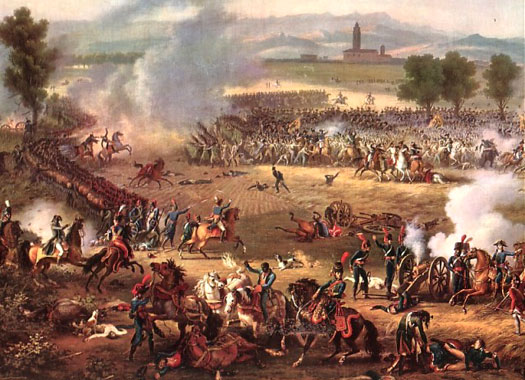 One of Napoleon's most brilliant achievements was his Italian campaign, which ended with the Battle of Marengo on 14 June 1800 - Austria was ejected from Northern Italy and French power there was now unquestioned One of Napoleon's most brilliant achievements was his Italian campaign, which ended with the Battle of Marengo on 14 June 1800 - Austria was ejected from Northern Italy and French power there was now unquestioned |
|
| 1801 |
On 8 January Czar Paul I signs a decree which incorporates the kingdom of [ Kartli-Kakheti](EasternGeorgia.htm#Kingdom of Kartl-Kakheti) in eastern Georgia into the empire. King Giorgi is deposed as Russia formally annexes the state on 12 September. The western Georgian kingdom of [Imeretia](EasternGeorgia.htm#Kingdom of Imereti) retains its independence for the time being. |
|
| 1801 - 1825 |
Alexander I |
Son. Implicated in coup. First grand duke of [ Finland](ScandinaviaFinland.htm#Grand Duchy Russian). |
| 1804 |
King Solomoni II is attempting to enlist Ottoman and Persian support for [Imeretia](EasternGeorgia.htm#Kingdom of Imereti) in preparation for the anticipated Russian encroachment on his borders. The Russian commander in the region is Prince Pavel Tsitsianov. He marches his army into Imeretia and forces Solomoni to accept vassalage under the terms of the convention of Elaznauri, on 25 April 1804. This effectively triggers a Russo-Persian War (1804-1813) which sees some early Persian victories followed by defeats, stalemate, and the effective loss of Dagestan, Georgia, and Azerbaijan. |
|
| 1805 |
The Third Coalition is formed against [France](FranceFranks.htm#First Empire) so, in a swift campaign, Napoleon marches east, occupies the [ Austrian](GermanyAustria.htm#Habsburg Archdukes %28Lorraine%29) capital of Vienna, and defeats large armies of Austrians and Russians at Austerlitz. The coalition lies in ruins. |
|
| 1806 |
Russia takes the principalities of [Moldavia](EasternMoldavia.htm#Tax Farmer) and [Wallachia](EasternWallachia.htm#Tax Farmer) from the Ottomans in battle and occupies the region. Upon the advance into Russia of the[French](FranceFranks.htm#First Empire) Emperor Napoleon Bonaparte, they sign a quick treaty and evacuate their troops northwards. |
|
| 1807 |
Following the indecisive Battle of Eylau, Napoleon's [France](FranceFranks.htm#First Empire) utterly defeats the [ Austrians](GermanyAustria.htm#Habsburg Emperors) and Russians at the Battle of Friedland. The Russian army is forced to retreat in chaos from the battlefield, ending the Fourth Coalition and forcing Alexander to negotiate for peace. |
|
| 1809 |
The Finnish War is fought between Sweden and Russia, part of the wider Napoleonic Wars. Russia has long coveted control of the grand duchy of Finland, and between February 1808 to September 1809 it is able to annexe what is in effect the eastern third of Sweden. This vast area is detached as the now-autonomous grand duchy of [Finland](ScandinaviaFinland.htm#Grand Duchy Russian), with Czar Alexander as its titular head. The campaign is commanded by Barclay de Tolly, later Russian governor of Finland. 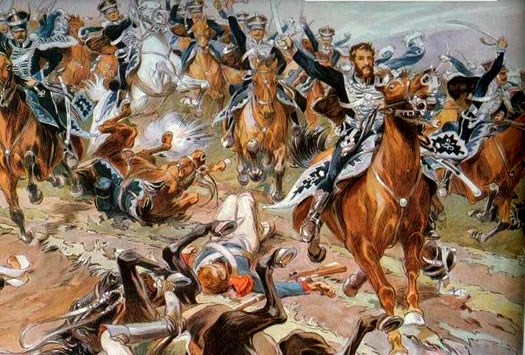 The Swedish plan of war in 1809 was largely based around the fortress of Sveaborg and waiting for reinforcements from Sweden itself, but the fortress' commanding officer, Karl Olof Cronstedt, inexplicably handed it over to the Russians following a brief barrage and the loss of six men The Swedish plan of war in 1809 was largely based around the fortress of Sveaborg and waiting for reinforcements from Sweden itself, but the fortress' commanding officer, Karl Olof Cronstedt, inexplicably handed it over to the Russians following a brief barrage and the loss of six men |
|
| 1810 |
Alexander abolishes the western Georgian kingdom of [Imeretia](EasternGeorgia.htm#Kingdom of Imereti) and removes its last king in violation of Russia's own protectorate treaty, on 20 February 1810. Later the same year the deposed king flees to Ottoman Akhaltsikhe when he learns of a Russian plot to kidnap him. |
|
| 1812 - 1813 |
Incensed by Russia's refusal to join his blockade of Britain, Napoleon invades with one of the largest armies Europe has ever seen. [Courland](EasternLivoniaCourland.htm#Russian Governors) is captured, and [Lithuania](EasternLithuania.htm#Russian Governors) is occupied, and the [French](FranceFranks.htm#First Empire) advance to Moscow. However, frustrated by the Russian policy of using the vast space of the country to defeat him, and perhaps unnerved by being ignored after his capture of Moscow, he is forced to retreat to Germany. In early 1813, Europe's armies mobilise against him, and a victory at Leipzig pushes the French back within their own borders. |
|
| 1815 |
Those Polish lands which had been under Russian control prior to the Napoleonic Wars are formally regained, with the territory being formed into the 'Polish Kingdom' in subordinate union with Russia, as established by the Congress of Vienna. The czar remains head of state as king of Poland. |
|
| 1825 - 1855 |
Nicholas I |
Brother. King of Poland. Grand duke of [ Finland](ScandinaviaFinland.htm#Grand Duchy Russian). |
| 1826 - 1828 |
The Russo-Persian War is the last major military conflict between the Russian and Persian empires, and the first time the two have fought each other since the Treaty of Gulistan of 1813. Shah Fath Ali is still desperate for increased foreign subsidies, and is advised by British agents to reconquer the territories that have been lost to Russia. On 28 July 1826, a 35,000-strong Persian army is led across the border by Abbas Mirza, invading the khanates of Talysh and Karabakh. The khans surrender their main cities to the Persians. However, Russian military power proves too much for them and eastern Armenia is taken before Persia agrees peace terms, bolstered in part by the start of the Russo-Turkish War. 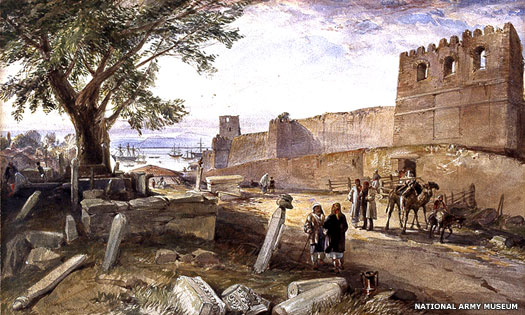 Sinope remains inhabited today, centred around the military fort shown here on 3 November 1855 by William Simpson, although the fort's presence makes archaeological digs very difficult (click or tap on image to view full sized) Sinope remains inhabited today, centred around the military fort shown here on 3 November 1855 by William Simpson, although the fort's presence makes archaeological digs very difficult (click or tap on image to view full sized) |
|
| 1828 - 1829 |
The Russo-Turkish War, triggered by the fighting in Greece and the Danubian principalities, ends in the Peace of Adrianople. The Ottoman sultan closes the Dardanelles to Russian vessels but the Russians lay siege to three major Ottoman cities in Bulgaria. In the end, despite an embarrassing defeat along the way, Russia wins the mouth of the Danube and much of the Black Sea's western coast under the terms of the peace, or Treaty of Adrianople. [Serbia](EasternSerbia.htm#Principality of Serbia) also achieves autonomy. |
|
| 1839 - 1840 |
Nicholas sends an expedition to Khiva, purportedly to free slaves who had been captured from areas of the Russian frontier and sold by Turkmen raiders. Britain is already involved in the First Anglo-Afghan War in Afghanistan but, despite sending over five thousand infantry, the Russian force stumbles into one of harshest winters in living memory. It is driven back by the weather and by its losses in early 1840. Britain persuades the khan of Khiva to outlaw the slave trade, removing Russia's excuse to attempt a re-invasion. |
|
| 1848 |
Undeterred by previous setbacks, Russia builds Fort Aralsk at the mouth of the Syr Darya. From here the empire begins a steady process of encroachment upon the lands of [ Bukhara](../KingListsFarEast/AsiaSogdiana.htm#Bukhara Emirate), Khiva, and Kokend. Russia meets stiff resistance all the way but its resources far exceed those of its opponents. |
|
| 1854 - 1856 |
Britain and [France](FranceFranks.htm#Second Empire) join the Ottoman empire in the Crimean War against Russia, to halt Russian expansion. The war ends with the signing of the Treaty of Paris, a severe setback to Russian ambitions. In the meantime, Czar Nicholas has died of pneumonia. 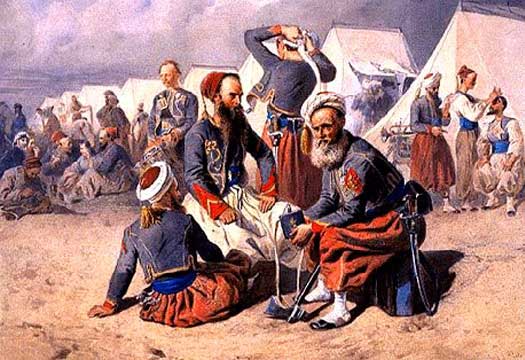 This illustration of French Zouaves (light infantry, generally drawn from North Africa) in Crimea was published in The Charleston Mercury on 21 November 1861 This illustration of French Zouaves (light infantry, generally drawn from North Africa) in Crimea was published in The Charleston Mercury on 21 November 1861 |
|
| 1855 - 1881 |
Alexander II |
Son. Assassinated by revolutionaries. |
| 1861 |
The 'Emancipation Reform of 1861' - more literally known as the 'Peasants' Reform' - abolishes serfdom in the Russian empire. The act frees up to twenty-three million people. (Serfs living on state-owned lands are freed in 1866.) |
|
| 1863 |
The period between 22 January 1863 to April 1865 witnesses the 'Second (January) Insurrection', or January Uprising in Poland. The uprising takes place across much of the former Polish-Lithuanian Commonwealth, including Poland, [Lithuania](EasternLithuania.htm#Russian Governors), the Baltic Provinces, Latgallia, and [Livonia](EasternLatvia.htm#Russian Governors). Following this, Congress Poland is administered as an integral part of Russia. In the same year, the Language Decree is issued in [Finland](ScandinaviaFinland.htm#Grand Duchy Russian) by Alexander. It marks the beginning of the process through which Finnish becomes an official administrative language. Although only one seventh of the Finnish population speaks Swedish as its first language, Swedish retains its dominant position until the beginning of the twentieth century. In the same year, the Finnish Diet is convened after a break of more than half a century. From now on, the Diet meets regularly, and active legislative work begins in Finland. |
|
| 1866 - 1867 |
An uprising in Georgia is put down. The following year, the United States senate purchases Russian America (Alaska and northern California) from Russia for just US$7.2 million. Alexander lets it go because he fears that the British in Canada will invade and seize it. |
|
| 1873 |
Khiva is finally conquered by Russia, on the third attempt. Russian General von Kaufman leads 13,000 infantry and cavalry, taking the capital, Khiva, on 28 May 1873. The city's fall is recorded by artist Vasily Vereshchagin. A treaty of August of the same year establishes Khiva as a Russian protectorate which retains its own rulers but only with nominal independence. Russia establishes a fixed boundary between Afghanistan and its new territories ([ Bukhara](../KingListsFarEast/AsiaSogdiana.htm#Bukhara Emirate), Tashkent, and Khiva, all of which go into forming Uzbekistan in 1924), promising to respect Afghanistan's territorial integrity. 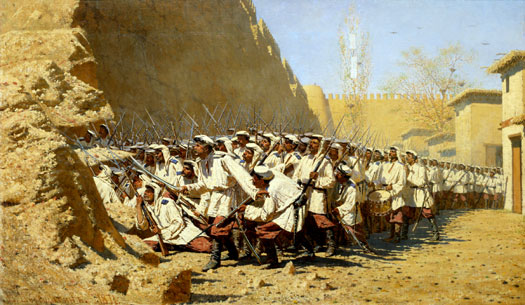 Russia's determination to capture Khiva led it farther and farther east and south around the shore of the Caspian Sea - until Khiva was finally taken in 1873 and the artist Vasily Vereshchagin could be present to capture this scene of Russian troops entering the capital Russia's determination to capture Khiva led it farther and farther east and south around the shore of the Caspian Sea - until Khiva was finally taken in 1873 and the artist Vasily Vereshchagin could be present to capture this scene of Russian troops entering the capital |
|
| 1881 - 1894 |
Alexander III |
Son. Died of cancer. |
| 1881 |
The first modern-era wave of Jewish Diaspora migrations back to Palestine begins with an event known as the First Aliyah. The Jews are fleeing pogroms in Eastern Europe, most notably in the territories of the Russian empire under Alexander III and his imposition of anti-liberalisation reforms. These may be partially the result of the January Uprising of 1863. Russia operates an area known as the '[Pale of Settlement](EasternLithuania.htm#Russian Governors)', largely territory to the west which has been acquired from the former Polish-Lithuanian commonwealth. Today this forms Russia's western border region and, from 1791-1793, it has incorporated modern Belarus (eastern Poland at the time), eastern [Latvia](EasternLatvia.htm#Russian Governors),[Lithuania](EasternLithuania.htm#Russian Governors), the province of Bessarabia (modern Moldova), and western Ukraine. The Jewish population of the 'Pale' (mainly Ashkenazi Jews) is restricted from moving eastwards into Russia proper and is now being discouraged from remaining in the western border regions of the empire. Some of their number end up elsewhere in the world, especially the USA, but also [ China](../KingListsFarEast/ChinaDynastiesOld.htm#Manchu Dynasty) where they form the Chinese Jews. |
|
| 1894 - 1917 |
Nicholas II |
Son. Last de facto Czar. Murdered in 1918. |
| 1899 - 1905 |
The grand duchy of [Finland](ScandinaviaFinland.htm#Grand Duchy Russian) has long been a sore point for Russian imperialists. It is a state within a state, with its own senate and its own Diet, its own local officials, legislation, army, money (the mark) and postage stamps. And to top it all off, Finland is separated from the empire by an official border. The obliteration of 'Finnish separatism', a policy also known as Russification, begins during the 'First Era of Oppression' which is driven by Nicholas. 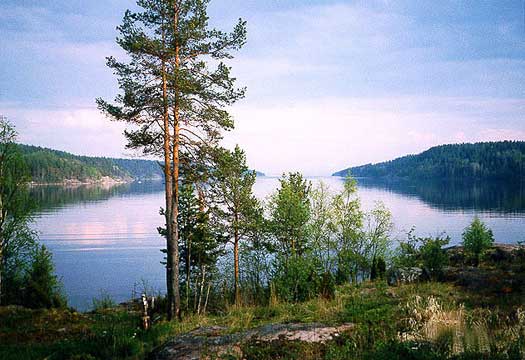 The lakes and forests of Karelia formed the official eastern Finnish-Russian border from the start of the nineteenth century The lakes and forests of Karelia formed the official eastern Finnish-Russian border from the start of the nineteenth century |
|
| 1903 - 1914 |
The Second Aliyah to Palestine is triggered in 1903 by an anti-Jewish riot in the city of Kishinev (modern Chişinău), the capital of the province of Bessarabia (modern Moldova), part of the Russian empire. Something like forty thousand members of the Jewish Diaspora settle in Palestine (mainly Ashkenazi Jews), although only half remain permanently. Many others, evicted from their settlements in the '[Pale](EasternLithuania.htm#Russian Governors)' head towards western Poland or America (something which is dramatically highlighted, if with a touch of artistic licence, in the film musical, Fiddler on the Roof, 1971. which has its final scenes set in 1905). |
|
| 1905 |
Russian troops fire on protestors in St Petersburg (an event dubbed 'Bloody Sunday'), sparking the 1905 Russian Revolution. The outcome of the revolution is especially noticeable in [Finland](ScandinaviaFinland.htm#Grand Duchy Russian), which makes a great leap forwards in the application of democratic governance, and in Armenia and Azerbaijan, which gain considerably more freedom as a result. 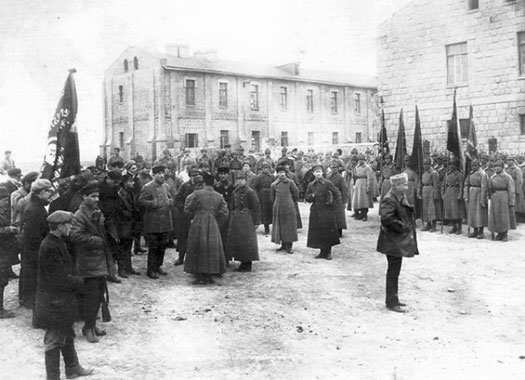 The Russian Revolution of 1905 brought suffering and around 1,500 Armenian dead, but its aftermath saw a reversal in the imperial policy of 'Russification' and greater freedoms for Armenians in general The Russian Revolution of 1905 brought suffering and around 1,500 Armenian dead, but its aftermath saw a reversal in the imperial policy of 'Russification' and greater freedoms for Armenians in general |
|
| The Poles fare less well, facing brutal repressions. In September of the same year, [ Japan](../KingListsFarEast/JapanDynastiesOld.htm#Modern Period) and Russia sign the Treaty of Portsmouth, ending the Russo-Japanese War (1904-1905) and confirming Japan's dominance in Korea. |
|
|
| 1912 |
The illiterate Siberian starets (a mystic, or holy man), Grigori Rasputin, cements his hold over Czarina Alexandra (a granddaughter of Britain's Queen Victoria). Her son, Alexei, is a haemophiliac whom no modern medical practitioners can seemingly help. She has turned increasingly to various starets, and now to Rasputin, following a head injury to Alexei which had threatened to continue bleeding until he was dead. Instead the bleeding stops the day after Rasputin advises her to dismiss the doctors. His influence steadily increases, seemingly to the detriment of the empire, until he is murdered by persons unknown on 30 December 1916. 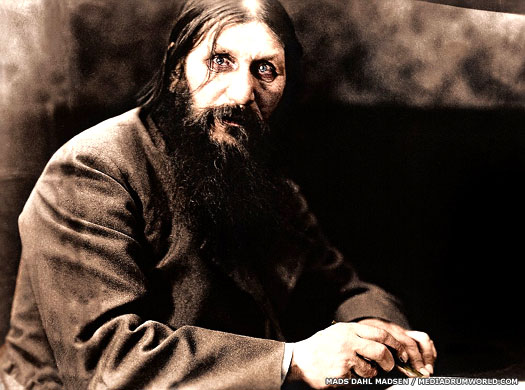 Grigori Rasputin exhibited a startling and, to many in the imperial court, troubling level of influence over the czarina and, through her, the czar himself, so Rasputin had to be removed from the scene Grigori Rasputin exhibited a startling and, to many in the imperial court, troubling level of influence over the czarina and, through her, the czar himself, so Rasputin had to be removed from the scene |
|
| 1914 |
Having jointly guaranteed in 1839 to support the neutrality of Belgium, when the country is invaded by Germany, Britain, France, and Russia are forced to declare war against imperial Germany and [Austria](GermanyAustria.htm#Habsburg Emperors) at midnight on 4 August in what becomes known as the Great War or First World War. However, the Russian army advancing into Eastern Europe is routed by the Germans at the Battle of Tannenberg, and Russian Poland is lost. |
|
| 1916 |
On the Eastern Front, Russian defeats bring the Baltic states, Estonia, [Latvia](EasternLatvia.htm#Russian Governors), and [Lithuania](EasternLithuania.htm#Russian Governors), under German imperial control, much to the relief of the German-descended land-owning aristocracy. |
|
| 1917 |
The February Revolution begins with riots in Petrograd over food rations and the conduct of the First World War against the German empire, and it ends with the creation of a Bolshevik Russian republic following the October Revolution. Nicholas II abdicates, first in favour of his son, Alexei, and then in favour of his brother, Michael. The act effectively ends a thousand years of royal rule. Mismanaging their own administration of the country and badly handling the war effort, the Bolsheviks start to lose control of some of Russia's imperial dominions, and Russia slides into civil war. 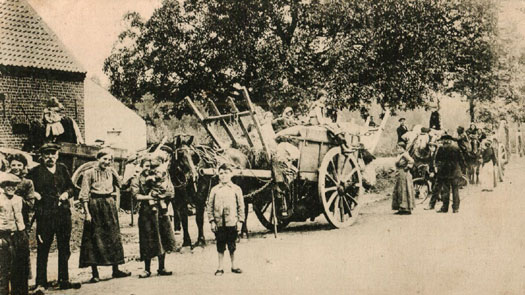 Belgian refugees (looking surprisingly jolly) were photographed here in 1914, on the road between Malines and Brussels while they attempted to outrun the invading imperial German army Belgian refugees (looking surprisingly jolly) were photographed here in 1914, on the road between Malines and Brussels while they attempted to outrun the invading imperial German army |
|
| 1917 |
Alexei |
Son. Provisional czar for eight hours. |
| 1917 |
Grand Duke Michael (II) Alexandrovich |
Second son of Alexander II. Executed 1918. |
| 1917 - 1918 |
Grand Duke Michael, pronounced Michael II by his brother, defers his ascension to the throne until his rule can be ratified. Instead, and under pressure, he authorises the provisional government to rule. His uncrowned reign ends when he is executed the following year. His death is legally recognised by a court of law in 1924, at which time Grand Duke Cyril Vladimirovich becomes the recognised head of the House of Romanov and the legitimate heir to the Romanov throne. The new Soviet Union, though, shows no signs of entertaining a return to imperial control. |
|
 |
|
|

 The short-lived Kazan khanate was conquered in 1552 by the resurgent Rus under the leadership of Ivan IV just over a century after Ulugh Muhammad had founded it
The short-lived Kazan khanate was conquered in 1552 by the resurgent Rus under the leadership of Ivan IV just over a century after Ulugh Muhammad had founded it This map of the Nordic countries and the western czarate after AD 1581 reveal the massive advance of Moscow's controlled territories since the ending of Mongol overlordship (click or tap on map to view full sized)
This map of the Nordic countries and the western czarate after AD 1581 reveal the massive advance of Moscow's controlled territories since the ending of Mongol overlordship (click or tap on map to view full sized) The late fifteenth century Olavinlinna Castle was constructed in Savonlinna by Erik Axelsson in an attempt to lay claim to the recently acquired Russian side of the Finnish border
The late fifteenth century Olavinlinna Castle was constructed in Savonlinna by Erik Axelsson in an attempt to lay claim to the recently acquired Russian side of the Finnish border Ingrians were the Finno-Ugric cousins of the Estonians, Finns, Livs, Karelians, Wots, and Weps, many of whom were forcibly integrated into the Russian czarate and later empire
Ingrians were the Finno-Ugric cousins of the Estonians, Finns, Livs, Karelians, Wots, and Weps, many of whom were forcibly integrated into the Russian czarate and later empire
 Michael Romanov was the first Russian czar of the House of Romanov, but it would be his successors who turned the czarate of the Russias into an empire
Michael Romanov was the first Russian czar of the House of Romanov, but it would be his successors who turned the czarate of the Russias into an empire The reforms of Aleksei and Patriarch Nikon to Russian Orthodox ritual and worship causes a section of the Church's congregation to secede during the Great Schism. Many 'Old Believers' who refuse to follow the new practises migrate westwards, to the shores of Lake Peipsi in Estonia to form small fishing communities which continue to trade at St Petersburg (see feature link). Others are killed in their thousands, or commit suicide by setting themselves alight rather than obey the czar's reforms.
The reforms of Aleksei and Patriarch Nikon to Russian Orthodox ritual and worship causes a section of the Church's congregation to secede during the Great Schism. Many 'Old Believers' who refuse to follow the new practises migrate westwards, to the shores of Lake Peipsi in Estonia to form small fishing communities which continue to trade at St Petersburg (see feature link). Others are killed in their thousands, or commit suicide by setting themselves alight rather than obey the czar's reforms. The Swedes had removed themselves from the Union of Kalmar with Denmark and Norway in 1523, and since that time had built up a Nordic empire of their own which now dominated the eastern lands and Baltic territories - prime targets for Russian expansion (click or tap on map to view full sized)
The Swedes had removed themselves from the Union of Kalmar with Denmark and Norway in 1523, and since that time had built up a Nordic empire of their own which now dominated the eastern lands and Baltic territories - prime targets for Russian expansion (click or tap on map to view full sized) The Streltsy Uprising resulted in executions, as depicted in this fragment of the 'Morning of the Streltsy execution'
The Streltsy Uprising resulted in executions, as depicted in this fragment of the 'Morning of the Streltsy execution' European victory at the Battle of Lepanto (in which Venice's navy was heavily involved) was considered the saviour of Europe itself from the advancing Ottoman threat, shown in this 1640 oil by Andries van Eertvelt (1590-1652)
European victory at the Battle of Lepanto (in which Venice's navy was heavily involved) was considered the saviour of Europe itself from the advancing Ottoman threat, shown in this 1640 oil by Andries van Eertvelt (1590-1652) The capture of the town of Malmo in 1709 by Count Magnus Stenbock was probably one of the last Swedish victories as Russia and her allies defeated the Swedes later the same year
The capture of the town of Malmo in 1709 by Count Magnus Stenbock was probably one of the last Swedish victories as Russia and her allies defeated the Swedes later the same year This map displays Nordic borders following the conclusion of the Great Northern War in 1721 (click or tap on map to view full sized)
This map displays Nordic borders following the conclusion of the Great Northern War in 1721 (click or tap on map to view full sized) Peter the Great spotted the military weakness of Iran and its provinces and began a long-running Russian push to extend his empire's borders southwards with his modernised army
Peter the Great spotted the military weakness of Iran and its provinces and began a long-running Russian push to extend his empire's borders southwards with his modernised army The War of the Austrian Succession saw Europe go to war to decide whether Maria Theresa would secure the throne left to her by her father, but several other issues were also decided as a wide range of wars were involved in the overall conflict
The War of the Austrian Succession saw Europe go to war to decide whether Maria Theresa would secure the throne left to her by her father, but several other issues were also decided as a wide range of wars were involved in the overall conflict Torelli Stefano's Allegory of Catherine the Great's Victory over the Turks and Tatars was painted in 1772, combining images of concrete historical personages with figures from the artists' free-flying imagination - the painting was commissioned to glorify the victory of the Russian army in the first Russo-Turkish War (1768-1774) and Catherine the Great is portrayed as the goddess Minerva in a triumphal chariot (click or tap on image to view full sized)
Torelli Stefano's Allegory of Catherine the Great's Victory over the Turks and Tatars was painted in 1772, combining images of concrete historical personages with figures from the artists' free-flying imagination - the painting was commissioned to glorify the victory of the Russian army in the first Russo-Turkish War (1768-1774) and Catherine the Great is portrayed as the goddess Minerva in a triumphal chariot (click or tap on image to view full sized) The city of Olsztyn (or Allenstein in German) was seized by Prussia in the 1772 partition of Poland-Lithuania, but Russia and Austria also seized their own prizes
The city of Olsztyn (or Allenstein in German) was seized by Prussia in the 1772 partition of Poland-Lithuania, but Russia and Austria also seized their own prizes The Siege of Azov in 1736 had been part of the greater Austro-Russo-Turkish War (1735-1739) and had already seen the Russians capture the Ottoman fortress of Azov for a second, and final, time in their ongoing on-off conflict
The Siege of Azov in 1736 had been part of the greater Austro-Russo-Turkish War (1735-1739) and had already seen the Russians capture the Ottoman fortress of Azov for a second, and final, time in their ongoing on-off conflict The Second Russo-Persian War in 1787-1792 witnessed a continuation of imperial Russia's push to extend its borders southwards at the expense of the weakening Muslim powers
The Second Russo-Persian War in 1787-1792 witnessed a continuation of imperial Russia's push to extend its borders southwards at the expense of the weakening Muslim powers One of Napoleon's most brilliant achievements was his Italian campaign, which ended with the Battle of Marengo on 14 June 1800 - Austria was ejected from Northern Italy and French power there was now unquestioned
One of Napoleon's most brilliant achievements was his Italian campaign, which ended with the Battle of Marengo on 14 June 1800 - Austria was ejected from Northern Italy and French power there was now unquestioned The Swedish plan of war in 1809 was largely based around the fortress of Sveaborg and waiting for reinforcements from Sweden itself, but the fortress' commanding officer, Karl Olof Cronstedt, inexplicably handed it over to the Russians following a brief barrage and the loss of six men
The Swedish plan of war in 1809 was largely based around the fortress of Sveaborg and waiting for reinforcements from Sweden itself, but the fortress' commanding officer, Karl Olof Cronstedt, inexplicably handed it over to the Russians following a brief barrage and the loss of six men Sinope remains inhabited today, centred around the military fort shown here on 3 November 1855 by William Simpson, although the fort's presence makes archaeological digs very difficult (click or tap on image to view full sized)
Sinope remains inhabited today, centred around the military fort shown here on 3 November 1855 by William Simpson, although the fort's presence makes archaeological digs very difficult (click or tap on image to view full sized) This illustration of French Zouaves (light infantry, generally drawn from North Africa) in Crimea was published in The Charleston Mercury on 21 November 1861
This illustration of French Zouaves (light infantry, generally drawn from North Africa) in Crimea was published in The Charleston Mercury on 21 November 1861 Russia's determination to capture Khiva led it farther and farther east and south around the shore of the Caspian Sea - until Khiva was finally taken in 1873 and the artist Vasily Vereshchagin could be present to capture this scene of Russian troops entering the capital
Russia's determination to capture Khiva led it farther and farther east and south around the shore of the Caspian Sea - until Khiva was finally taken in 1873 and the artist Vasily Vereshchagin could be present to capture this scene of Russian troops entering the capital The lakes and forests of Karelia formed the official eastern Finnish-Russian border from the start of the nineteenth century
The lakes and forests of Karelia formed the official eastern Finnish-Russian border from the start of the nineteenth century The Russian Revolution of 1905 brought suffering and around 1,500 Armenian dead, but its aftermath saw a reversal in the imperial policy of 'Russification' and greater freedoms for Armenians in general
The Russian Revolution of 1905 brought suffering and around 1,500 Armenian dead, but its aftermath saw a reversal in the imperial policy of 'Russification' and greater freedoms for Armenians in general Grigori Rasputin exhibited a startling and, to many in the imperial court, troubling level of influence over the czarina and, through her, the czar himself, so Rasputin had to be removed from the scene
Grigori Rasputin exhibited a startling and, to many in the imperial court, troubling level of influence over the czarina and, through her, the czar himself, so Rasputin had to be removed from the scene Belgian refugees (looking surprisingly jolly) were photographed here in 1914, on the road between Malines and Brussels while they attempted to outrun the invading imperial German army
Belgian refugees (looking surprisingly jolly) were photographed here in 1914, on the road between Malines and Brussels while they attempted to outrun the invading imperial German army